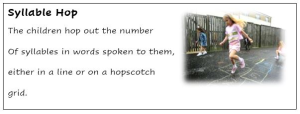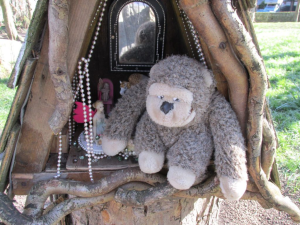Preschool is a magical time filled with curiosity, exploration, and the joy of learning.
One essential aspect of language development that preschoolers can explore is understanding and recognizing syllables.
Syllables are the building blocks of words and mastering them opens the door to improved pronunciation, vocabulary expansion, and enhanced reading skills.
To make this journey of syllable discovery exciting and engaging, we’ve compiled a list of Playful Syllable Activities for Preschool and foster their love for language.
Syllable Hopscotch:

Hopscotch is a classic game that can be transformed into a fun syllable activity. Create a hopscotch grid using sidewalk chalk or masking tape, labeling each square with a word. Children take turns hopping to a square, saying the word out loud, and counting the number of syllables. For example, if they land on a square labeled “banana,” they would say “ba-na-na” while hopping on each syllable. This game combines physical activity, phonemic awareness, and syllable recognition, making it an engaging way for preschoolers to learn.
Silly Sentence Fun:

Preschoolers love being silly, so why not incorporate silliness into syllable activities? Invite children to create silly sentences using words with different numbers of syllables. Encourage them to think outside the box and use their imagination. For instance, a child might say, “The big purple elephant danced under the rainbow.” As they giggle and experiment with words, they develop an understanding of how different syllables can be combined to form unique and entertaining sentences.
Related: 20 Exciting Smell Activities for Preschoolers
Syllable Sort:

Sorting games are an effective way to reinforce syllable recognition. Prepare a collection of picture cards representing various objects or animals, each with a different number of syllables in its name. Spread the cards out on a table or floor, and invite children to sort them into groups based on the number of syllables. This activity not only sharpens their syllable awareness but also enhances their vocabulary and categorization skills.
Syllable Sound Hunt:

Take the preschoolers on a syllable sound adventure in the classroom or outdoors. Provide them with a list of words or objects with varying syllable counts, such as “cat,” “butterfly,” or “watermelon.” Encourage the children to explore their surroundings, find objects that match the given syllable count, and share their discoveries with the group. This activity helps preschoolers develop their listening skills and reinforce their understanding of syllables in real-world contexts.
Related: 20 Fun Diversity Crafts for Preschoolers
Puppet Show:

Puppets add an element of excitement and playfulness to any learning activity. Organize a puppet show where each puppet introduces itself with a name that contains a specific number of syllables. The preschoolers can take turns manipulating the puppets, making them say their names, and counting the syllables. This interactive and imaginative activity not only helps children identify syllables but also enhances their storytelling abilities and boosts their confidence in public speaking.
Syllable Sensory Bin:

Create a sensory bin filled with various objects or pictures representing words with different syllable counts. Provide tools like tongs or scoops for children to explore and sort the objects based on the number of syllables they hear. This hands-on activity engages multiple senses, reinforcing syllable recognition while enhancing fine motor skills and sensory exploration.
Syllable Scavenger Hunt:

Design a syllable scavenger hunt where children search for hidden objects or pictures with different syllable counts. Create clues or riddles related to the syllables, leading them from one hiding spot to the next. As they find each item, they can say the word out loud and count the syllables. This game promotes critical thinking, problem-solving, and syllable identification in an exciting and interactive way.
Syllable Puzzles:

Create simple puzzles by writing words with varying syllable counts on separate puzzle pieces. Cut the puzzles into syllables so that children can arrange them to form complete words. They can say the word out loud and clap or stomp for each syllable as they complete each puzzle. This activity strengthens fine motor skills, visual perception, and syllable recognition simultaneously.
Syllable Charades:

Play a game of syllable charades where children act out words with different syllable counts without using any spoken words. They can use gestures, facial expressions, or body movements to convey the meaning of the word while others guess the correct number of syllables. This activity enhances communication skills, creativity, and syllable awareness in an interactive and playful manner.
Syllable Book Hunt:

Select a few storybooks or picture books and invite children to hunt for words with specific syllable counts within the pages. Provide them with a list of syllable counts and ask them to locate and mark words accordingly. As they find each word, they can read it aloud, clap or stomp for each syllable, and share their discoveries with the group. This activity promotes literacy skills, and vocabulary development, and reinforces syllable recognition within the context of storytelling.
Syllable Memory Game:

Create a set of cards with pictures or words that have different syllable counts. Mix them up and place them face-down on a table. Children take turns flipping two cards and saying the word out loud, clapping or stomping for each syllable. If they find a match, they keep the pair. This game improves memory skills, and concentration, and reinforces syllable recognition in a fun and interactive way.
Syllable Musical Chairs:

Set up a circle of chairs, one fewer than the number of children participating. Place picture cards or word cards with different syllable counts on each chair. Play music while children walk around the chairs. When the music stops, they sit on a chair and say the word out loud, counting the syllables. Remove one chair each round. This activity combines movement, syllable recognition, and a dash of excitement.
Syllable Storytelling:
Create a collaborative storytelling activity where each child contributes a sentence to a story, with each sentence containing a word with a specific number of syllables. Start the story with a one-syllable word, and continue building upon it with two, three, or more syllable words. This activity encourages creativity, and vocabulary expansion, and reinforces syllable awareness within the context of storytelling.
Syllable Jigsaw Puzzles:

Make jigsaw puzzles with words written on each piece. Cut the puzzles along syllable boundaries, creating separate pieces for each syllable. Children can then assemble the puzzles by matching the syllables to form complete words. As they complete each puzzle, they can say the word out loud, clapping or stomping for each syllable. This activity strengthens fine motor skills, and visual perception, and reinforces syllable recognition.
Syllable Bingo:

Create bingo cards with words or pictures that have different syllable counts. Call out words randomly, and children mark the corresponding syllable count on their bingo cards. The first one to get a line or complete their card shouts “Syllable Bingo!” This game enhances listening skills, and concentration, and reinforces syllable recognition in a playful and competitive manner.
Syllable Puppet Theater:

Set up a puppet theater and provide children with puppets and props. Encourage them to create short skits or stories where the puppets use words with different syllable counts. As the puppets perform, the children can clap or stomp for each syllable in the spoken words. This activity promotes creativity, and storytelling skills, and reinforces syllable recognition through imaginative play.
Syllable Building Blocks:

Use building blocks with letters or syllables written on them. Children can arrange the blocks to form different words and count the syllables as they go. Encourage them to experiment with different combinations and create their own words with varying syllable counts. This hands-on activity enhances fine motor skills, and letter/sound recognition, and reinforces syllable understanding.
Syllable Bean Bag Toss:

Create a target board with different syllable counts labeled on it. Give children bean bags and ask them to throw them onto the target board. When a bean bag lands on a specific syllable count, the child must say a word with that number of syllables. This active game combines gross motor skills, coordination, and syllable recognition in an exciting and playful way.
Syllable Poetry:

Introduce children to simple syllable-based poems like haikus or limericks. Discuss the structure and syllable patterns of these poems, and encourage children to create their own syllable poems. Provide them with examples and prompts to guide their creativity. This activity enhances language skills, and poetic expression, and reinforces syllable awareness.
Syllable Relay Race:

Organize a relay race where children pass a baton or object to their teammates. Each team member must say a word with a specific number of syllables before passing the baton. The next teammate must say a word with a different syllable count, and so on. This lively activity combines teamwork, movement, and syllable recognition in a dynamic and competitive setting.

